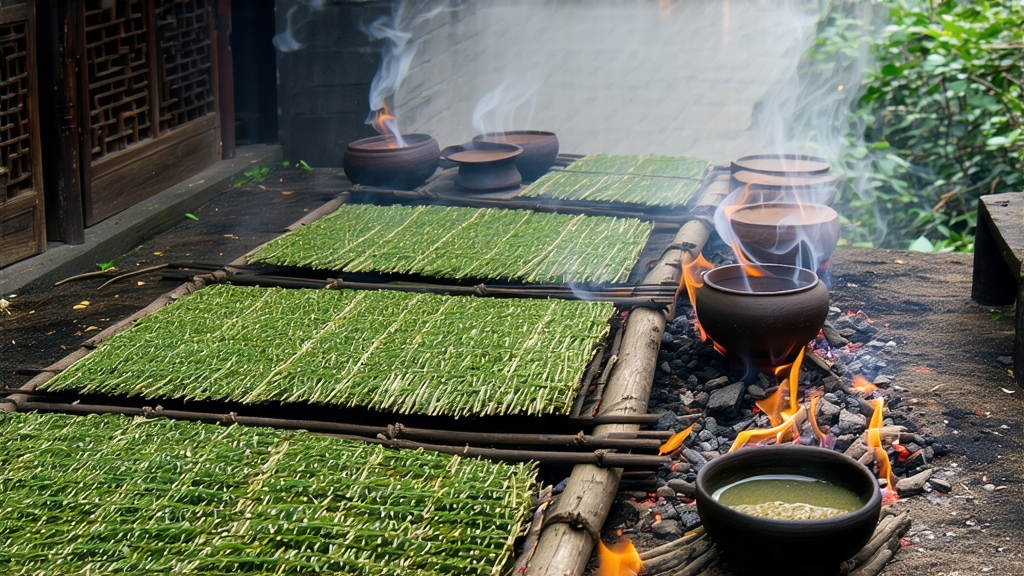
Ask most tea lovers to name China’s iconic black teas and Keemun or Dianhong roll easily off the tongue, yet the very first black tea ever created—Lapsang Souchong—remains shrouded in campfire myth and smoky mystique. Born in the precipitous Wuyi Mountains of northern Fujian, this “Zheng Shan Xiao Zhong” is not merely a beverage; it is a time capsule of Ming-dynasty ingenuity, Dutch maritime trade, and the Chinese gift of aroma to the world. The following 2,000-word journey will escort you from the granite gorges of Tongmu Village to your own teapot, revealing why the original pine-smoked black tea still commands the loyalty of connoisseurs from Paris to Tokyo.
-
Historical backdrop: from green to black by accident or design?
Local legend claims Lapsang Souchong emerged in 1568 when a passing army commandeered a tea factory, forcing farmers to rush-dry their half-oxidized leaves over fresh pine fires to meet the next day’s market. Whether apocryphal or not, the story underscores two truths: Wuyi tea makers were already experimenting with oxidation, and the pine smoke was a deliberate preservative in a humid mountain climate. By 1604 Dutch traders had ferried the novel “bohea” (a corruption of “Wuyi”) to Europe, where it oured Portuguese-controlled Japanese green tea and ignited Britain’s two-century tea craze. Samuel Pepys’ 1660 diary entry mentioning “a cup of tee” almost certainly referred to this smoky Fujian leaf. Thus, Lapsang Souchong is the progenitor of every subsequent black tea on earth. -
Terroir: why only Tongmu can claim the original name
Chinese law is unusually terroir-centric: only leaf picked within the 565 km² core of Wuyi National Park may be sold as “Zheng Shan” (original mountain). The region’s subtropical monsoon climate, 80 % humidity, and 2,000 mm annual rainfall nurture wild tea bushes (Camellia sinensis var. sinensis) among dwarf bamboo, azalea, and cedar. Diurnal temperature swings of 10 °C slow growth, concentrating amino acids and sugars that balance the forthcoming smoke. Granitic, slightly acidic soils (pH 4.5–5) force roots to struggle, yielding smaller leaves with higher essential oil content—the very compounds that bond with pine smoke to create the tea’s signature resinous sweetness. -
Cultivar and plucking standard
The traditional cultivar is “Xiao Ye Zhong” (small-leaf variety), kept as seed-propagated bushes rather than cloned hedges. Pickers follow the “two leaves and a bud, open like a sparrow’s beak” rule around the Qingming festival, when spring leaves are still thin-walled and porous—ideal for absorbing smoke later. Anything plucked after April 20 is diverted to unsmoked versions, as thicker summer leaves yield harsh, tarry notes. -
Crafting the smoke: a choreography of fire, wind, and time
a. Withering: 8–10 h on bamboo racks inside a charcoal-heated loft (35 °C) reduces moisture to 60 %.
b. Rolling: 45 min of light pressure ruptures cells without shredding the leaf, preparing enzymes for oxidation.
c. Oxidation: leaves rest 3–4 h in wooden troughs; mountain air microbes turn them mahogany while forming theaflavins and thearubigins.
d. Pan-firing: a 220 °C wok “kills green” in 3 min, locking in color.
e. Smoking: the signature step. Fresh pinus taiwanensis and massoniana logs are lit in an earthen floor pit; heat and smoke rise through a lattice of woven bamboo where tea is spread 1.5 m above. Craftsmen control airflow by adjusting ceiling flaps, ensuring the leaf “bathes” rather than “burns.” Two passes—each 2 h—are separated by 24 h of rest, allowing moisture migration and smoke absorption to equalize.
f. Final drying: 80 °C charcoal embers reduce moisture to 4 %, after which the tea is hand-sorted to remove stems and yellow leaves. -
Variations on a smoky